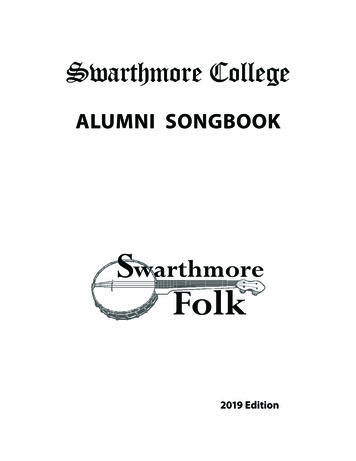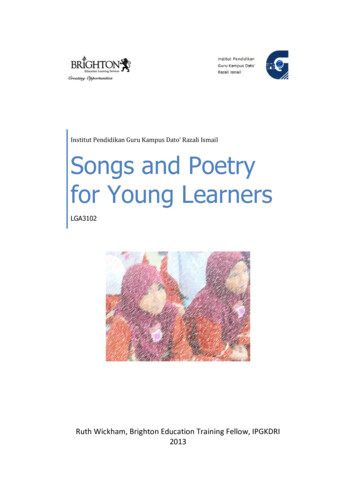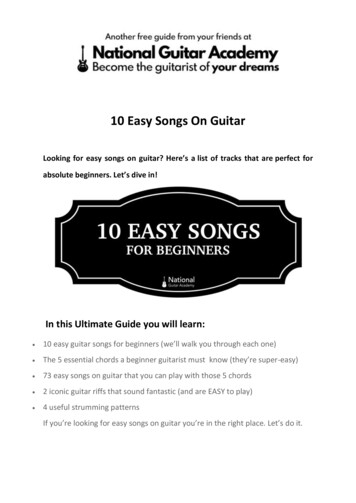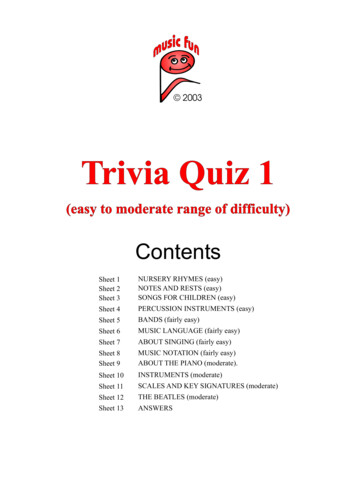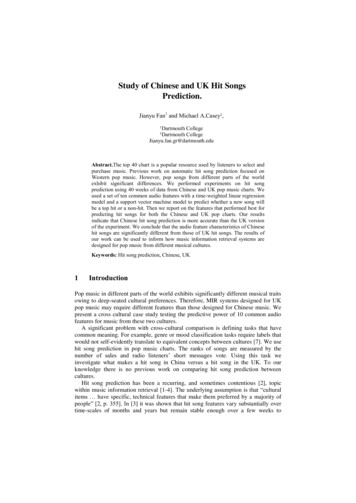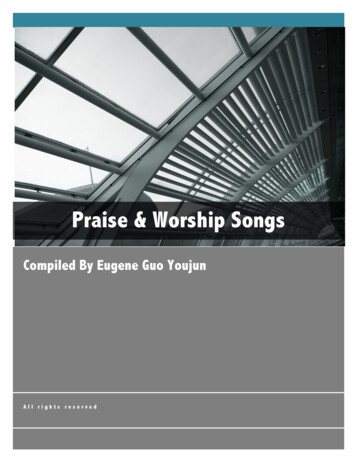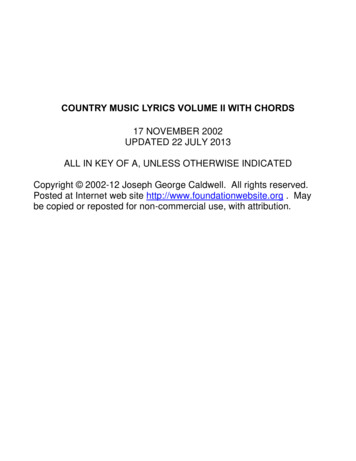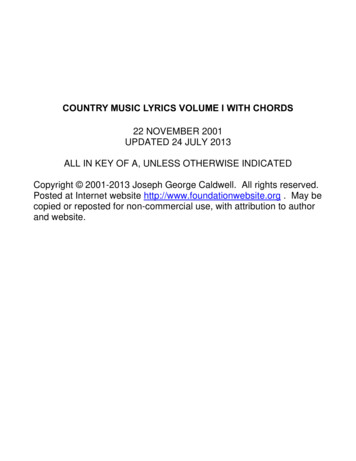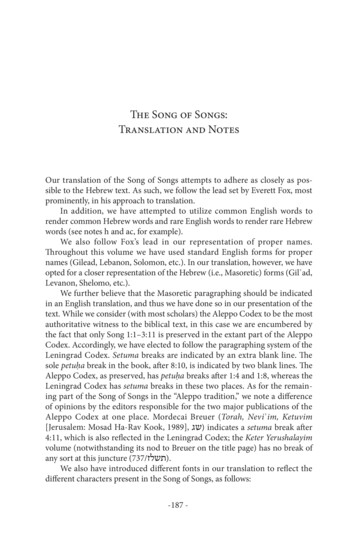
Transcription
The Song of Songs:Translation and NotesOur translation of the Song of Songs attempts to adhere as closely as possible to the Hebrew text. As such, we follow the lead set by Everett Fox, mostprominently, in his approach to translation.In addition, we have attempted to utilize common English words torender common Hebrew words and rare English words to render rare Hebrewwords (see notes h and ac, for example).We also follow Fox’s lead in our representation of proper names.Throughout this volume we have used standard English forms for propernames (Gilead, Lebanon, Solomon, etc.). In our translation, however, we haveopted for a closer representation of the Hebrew (i.e., Masoretic) forms (Gilʿad,Levanon, Shelomo, etc.).We further believe that the Masoretic paragraphing should be indicatedin an English translation, and thus we have done so in our presentation of thetext. While we consider (with most scholars) the Aleppo Codex to be the mostauthoritative witness to the biblical text, in this case we are encumbered bythe fact that only Song 1:1–3:11 is preserved in the extant part of the AleppoCodex. Accordingly, we have elected to follow the paragraphing system of theLeningrad Codex. Setuma breaks are indicated by an extra blank line. Thesole petuh a break in the book, after 8:10, is indicated by two blank lines. TheAleppo Codex, as preserved, has petuh a breaks after 1:4 and 1:8, whereas theLeningrad Codex has setuma breaks in these two places. As for the remaining part of the Song of Songs in the “Aleppo tradition,” we note a differenceof opinions by the editors responsible for the two major publications of theAleppo Codex at one place. Mordecai Breuer (Torah, Neviʾim, Ketuvim[Jerusalem: Mosad Ha-Rav Kook, 1989], )שג indicates a setuma break after4:11, which is also reflected in the Leningrad Codex; the Keter Yerushalayimvolume (notwithstanding its nod to Breuer on the title page) has no break ofany sort at this juncture (737/ )תשלז .We also have introduced different fonts in our translation to reflect thedifferent characters present in the Song of Songs, as follows:-187 -
188Solomon’s Vineyard Minion Pro is used for the two principal characters, with themore flowing italic Minion Pro used for the dominant femalevoice and the regular Minion Pro used for the responsive malevoice.The superscription in 1:1 is indicated by Garamond.The lines spoken by the chorus are produced in Gill Sans.The few lines spoken by the brothers, 8:8–9, in the mouthof the female, are indicated by Skia.Note that one cannot be absolutely certain about the attribution of all thespoken lines to a particular character (male lover, female lover) or group(chorus, brothers). Such uncertainty, however, probably is germane for onlyabout 10 percent of the lines. In most cases, when the second-person masculine singular forms (verbs, pronouns, etc.) are used, we assume that thefemale lover is speaking, addressing her beloved. Conversely, when the second-person feminine singular forms are used, we assume that the male loveris speaking.Finally, observe that there are two sets of notes accompanying our translation. The lettered notes (a, b, c) refer to general literary uses, while thenumbered notes (1, 2, 3) refer specifically to issues relevant to the hijāʾ andtašbīb genres raised in chapter 4. Scott B. Noegel and Gary A. Rendsburg,Solomon's Vineyard: Literary andLinguistic Studies in the Song of Songs(Atlanta: SBL Press, 2009).
Translation and Notes189The Song of Songs1:11:21:31:41:5The song of songs, which is Shelomo’s.1May he kiss me with the kisses of his mouth,For your love is better than wine.a 2To the scent of your good oils,“Turaq oil” b is your name;Therefore the maidens love you.3Draw me, after you let us run;The king has brought me to his chambers,Let us be glad and let us rejoice in you,Let us recall c your love more than wine,(More than) smooth-wine, they love you.Black am I, and comely,O daughters of Yerushalayim;Like the tents of Qedar,Like the curtains of Shelomo.5a. The shift from third person in the first stich to second person in the secondstich sounds odd to English ears, but this is common in Hebrew poetry.b. The Hebrew word turaq remains an enigma. Presumably it describes a particularly fine type of oil.c. The Hebrew root zkr typically means “remember,” thus our rendering “recall.”But a homonymous root, which serves as the basis for the common word zākār“male,” bears a sexual connotation. Accordingly, a second meaning is evident as well,something like “let us make-love your love.”1. Or, in light of the object of the invective, “the song of songs concerning Shelomo.” See also the references to this wealthiest of kings in 1:5; 3:7, 9, 11; 8:11, 12.2. The poet begins immediately with the wine imagery that will flow throughoutthe poem, a feature that the Song of Songs shares with Arabic hijāʾ poetry.3. The female lover notes that other women love the male protagonist as well,both here and in the final stich of the next verse. See also 6:9, though in this passagewe learn that other women acclaim the female lover. The praise by others, externalto the main characters, is another feature of hijāʾ poetry, on which see chapter 4, pp.152–53.4. Given the hijāʾ quality of the poem, we opt to retain MT here (see ch. 4, p. 141)and thereby reject the oft-proposed emendation to “Salma.”5. “The sons of my mother,” of course, is a poetic way of stating “brothers”(who would have to be full brothers, not half-brothers). Given that “brothers” canrefer to political allies in Biblical Hebrew (see ch. 4, pp. 157–58), we suggest that apolitical reading may be inherent here, as befitting the overall charges within hijāʾ
1901:61:71:81:9Solomon’s VineyardDo not look at me, that I am dark,That the sun has glared at me;The sons of my mother were angry at me,They set me as keeper of the vineyards,(But) my own vineyard I have not kept.6Tell me, O whom my inner-being d loves,7Where do you desire/shepherd? e 8Where do you cause-(them)-to-lie-down at noon?Lest I become like one-who-veils,fBeside the flocks of your friends.If you do not know, yourself,O most beautiful among women;Go out, yourself, by the footprints of the flock,And shepherd your kids,At the dwellings of the shepherds.To a mare in Pharaoh’s chariotry,9d. Here and throughout the translation we render nepeš with “inner-being,”which captures the essence of the ancient Hebrew understanding of the word betterthan English “soul” or other alternatives.e. Note the Janus parallelism (see ch. 1, §1.1.2, pp. 13–14), with the pivot wordtirʿe h meaning both “desire” (paralleling what precedes) and “shepherd” (anticipatingwhat follows).f. The notoriously difficult Hebrew term ʿôt yāh, on which see also chapter 4, p.154 n. 84.poetry. Among other relevant passages in the Song of Songs, see, for example, 8:1 with“brother” meaning “ally.”6. The first of numerous references to vineyards, orchards, and gardens withinthe Song of Songs, which is also characteristic of hijā’ poetry in the Arabic tradition(see ch. 4, pp. 147–49). See also 1:14; 2:13, 15; 4:12, 13, 15, 16; 5:1, 13; 6:2, 11; 7:13;8:11–12, 13.7. The Hebrew root ʾhb “love” is used for “fealty” in a political sense throughoutthe Bible, and we suggest that this undertone is present in the Song of Songs as well(see ch. 4, p. 157).8. The double meaning in this word and the Janus parallelism inherent in thisverse is treated in note e (see also §1.1.2, pp. 13–14). Yet a third connotation is present,however. The verbal root rʿy can bear both humans as the subject, in which case thesense is “shepherd,” and animals as the subject, in which case the sense is “graze.” Withthe latter sense, however, the meaning can be extended to “devastate” ( “overgraze”),and thus this passage also contains a veiled critique of the king; see chapter 4, p. 153.9. One does not necessarily expect military terminology within love poetry, but
Translation and Notes191I liken you, my darling.101:10 Your cheeks are lovely with circlets,Your neck with strings-of-beads.1:11Circlets of gold we will make for you.With spangles of silver.1:12While g the king is on his divan,h 11My nard gives forth its scent1:13A sachet of myrrh is my beloved to me,Between my breasts may he lodge.1:14A cluster of henna is my beloved to me,From the vineyards of ʿEn Gedi.1:151:161:172:12:2Behold you are beautiful, my darling,Behold you are beautiful, your eyes are doves.Behold you are beautiful, my beloved, indeed pleasant,Indeed our bed is verdant.The rafters of our house are cedars,Our runners are cypresses.I am a daffodil of the Sharon,A lily of the valleys.Like a lily among the brambles,So is my darling among the daughters.12g. Hebrew ʿad še-, rendered “until” throughout the Song of Songs, though we optfor “while” here for better sense.h. Hebrew mesab, a rare noun, rendered here with “divan,” a relatively rare English word. In addition, “divan” conveys a sense of royalty, aristocracy, and officialdomand thus befits the mention of the king here.the parallel with hijaʾ poetry (on which see ch. 4, p. 149–50) accounts for the presenceof such language in the Song of Songs. For other relevant passages, see 3:7-8; 4:4; 6:4,12, 7:5; 8:9–10.10. This is the first of many passages in the poem that extol the female lover butthat, in light of hijāʾ technique, are to be understood as satrirical praise. In addition,the term raʿyāh “darling” is the feminine form of rēaʿ “friend,” which elsewhere bearsthe political connotation of “ally” (see ch. 4, p. 158).11. Possibly the allusion here is to the laziness of the king (see also 3:7 and 9, withother furniture terms, where Shelomo is mentioned specifically by name). This wouldbe a very direct critique of royal behavior, needless to say; see further chapter 4, p. 167.12. Once the undertone of raʿyāh “darling” as “ally” is established (see n. 10), itis easy to sense the secondary meaning of bānôt “daughters” as “vassals” (see ch. 4, p.158–59).
1922:32:42:52:62:72:82:9Solomon’s VineyardLike an apricot-tree among the trees of the forest,So is my beloved among the sons;In his shade I delight and I sit,iAnd his fruit is sweet to my palate.13He brought me to the house of wine,And his glance j toward me is love.14Support me with raisin-cakes,Spread me among the apricots;For I am sick with love.His left-hand is beneath my head,And his right-hand embraces me.I adjure you, O daughters of Yerushalayim,By the gazelles, or by the hinds of the field;15Do not rouse, and do not arouse love,Until it desires.Hark, my beloved,Behold he comes,Bounding over the mountains,Leaping over the hills.My beloved is-likek a gazelle,i. The Hebrew construction collocates two suffix-conjugation verbs, separated bythe conjunctive “and.” A more idiomatic rendering would be “I delight to sit.”j. If taken from the Hebrew noun degel, then “his banner.” But we have chosento relate the word here to the Akkadian verb dagālu “see.” Of course, both meaningscould be inherent, given the thread of polysemy that permeates the book.k. The hyphenated form “is-like” is used here to render the verbal root d-m-h, incontrast to “is like” and “are like” in a number of other passages, where the Hebrewincludes the unexpressed copula followed by the preposition kә-. In four other passages (1:9; 2:17; 7:8; 8:14), we are able to avail ourselves of the verb “liken” to renderverbal forms of d-m-h.13. The erotic imagery here is part and parcel of the hijāʾ style.14. The noun ʾahăbāh “love” indicates “alliance,” once the political reading of theSong of Songs within the context of invective poetry is recognized. See also 2:5; 5:8and the refrains in 2:7; 3:5; 8:4.15. Here and in the parallel passage (3:5) the words s әbāʾôt and ʾaylôt can beunderstood as terms for “rulers, nobles,” in addition to which the first word carriesthe meaning of “armies.” Such political language shines through in the hijāʾ genre; seechapter 4, p. 163.
Translation and Notes2:102:112:122:13193Or a fawn of the hinds;16Behold, he stands behind our wall,Gazing through the windows,Peering through the lattices.l 17My beloved speaks, and he says to me:“Arise,m my darling, my beautiful, and go forth.For behold, the winter has passed,The rain has departed, gone.The blossoms appear in the land,The time of pruning/singing n has arrived;The voice of the turtledove is heard in our land.The fig-tree perfumes its young-fruit,l. Typically in biblical literature, we gain the male perspective, and thus we witness “the woman in the window” motif through a man’s eyes; that is, the “reader”is outside, and he or she views Rahab, Sisera’s mother, Michal, Jezebel, and LadyWisdom looking out beʿad hah allôn “through the window” (see ch. 4, p. 156, for references). Here, by contrast, we gain the female perspective. True, she remains insidethe house, which is the woman’s domain, but the “camera” is there with her as shelooks out to see her male lover approaching and peering min hah allônôt “through thewindow” (lit. “windows’) from without.m. The actual expression is qûmî lāk, with an additional element “you, yourself ” after the verb, as also occurs at the end of this stich in lәkî lāk. While we havemanaged to capture the latter with “go forth,” instead of simple “go,” we have notattempted to capture the former, but rather content ourselves with simple “arise.” Thesame wording occurs at 2:13.n. In one of the most brilliant of all passages in the Song—indeed, in the entireBible—we are treated here to a dazzling display of the poet’s talent with this Janus parallelism. The Hebrew word zāmîr, placed in the middle stich, means both “pruning”and “singing”; with the first meaning it looks back to the first stich and the key word“blossoms,” while with the second meaning it looks forward to the third stich with thekey phrase “voice of the turtledove.” See C. H. Gordon, “New Directions,” BASP 15(1978): 59–66.16. The first refrain above (2:7 3:5) introduces fauna (especially deer imagery)into the poem, the effect of which is heightened here by the female lover’s comparingher beloved to a gazelle or a fawn. This too is an element of hijaʾ poetry, as discussedin chapter 4, p. 149. Many other passages also refer to animals: 2:15, 17; 4:1–2 ( 6:56); 4:5 ( 7:4); 4:8; 5:11, 12; 6:9; 8:14.17. On the level of reading the Song of Songs as hijāʾ poetry, we note that genderreversal (see n. l) can serve to enhance the invective (see ch. 4, pp. 156–57).
194Solomon’s VineyardAnd the vines in bud, they give forth fragrance;Arise, my darling, my beautiful, and go forth.”o2:14O my dove, in the crannies of the rock,In the covert of the cliff,Show me your visage,Let me hear your voice;18For your voice is sweet,And your visage is lovely.2:15Catch us the foxes,The little foxes,Ruining the vineyards,And our vineyards in bud.19My beloved is mine, and I am his,Grazing among the lilies.20Until the day(-wind) blows,And the shadows flee;Turn, liken yourself, my beloved, to a gazelle,Or to a fawn of the hinds,Upon the mountains of cleavage.p2:162:173:1On my couch at night,I sought whom my inner-being loves,o. Note that identical lines (2:10b, 13c) bracket the male lover’s speech to thefemale lover in her imagined 3.5-verse representation of his words.p. Hebrew beter (here in pausal form bāter) has elicited much discussion. Weprefer to derive the word from the verbal root b-t-r “cleave,” thus our rendering “cleavage,” and to see here a reference to the female lover’s breasts, imagined as mountains.That is to say, she invites her beloved to her breasts, echoing the sentiment expressedin 1:13.18. While the physical distance between the two lovers has been intimated fromthe outset (see 1:7), here we gain a reminder that the two lovers are apart. This pointcomprises an important component of hijā’ poetry (see ch. 4, pp. 145–46)—and seefurther below, especially 3:1; 5:6; 6:1.19. Since viticultural terms are used metaphorically for Israel in the Bible, quitepossibly the “foxes” here allude to Israel’s (sc. the vineyard’s) enemies attacking her.See chapter 4, p. 164.20. The reference to “grazing,” both here and in the parallel verse in 6:3, oncemore suggests an invective against the king (see above, n. 8 on 1:7).
Translation and Notes3:23:33:43:53:63:73:83:93:10195I sought him, but I did not find him.21Let me arise, please, and let me roam the city,In the streets and in the piazzas,Let me seek whom my inner-being loves;I sought him, but I did not find him.The watchmen found me,They who go-about the city;“He whom my inner-being loves, did you see (him)?”Scarcely had I passed them,When I found him whom my inner-being loves;I grabbed hold of him, and I would not let him loose,Until I brought him to the house of my mother,And to the chamber of she-who-conceived-me.I adjure you, O daughters of Yerushalayim,By the gazelles, or by the hinds of the field;Do not rouse, and do not arouse love,Until it desires.Who is this coming up from the wilderness,Like columns of smoke;Redolent with myrrh and frankincense,With every powder of the merchant.Behold the litter of Shelomo,Sixty heroes surround it, from among the heroes of Yisraʾel.All of them, grasping the sword,Trained in battle,Each-man, his sword on his thigh,For fear of the night.The king Shelomo made himself a palanquin,From the trees of the Levanon.Its pillars he made of silver,Its support of gold;Its riding-seat of purple,21. The poet here increases our awareness, in very direct wording, of the distancebetween the two lovers.
1963:11Solomon’s VineyardIts interior arranged/burning with leather/love,q 22From the daughters of Yerushalayim.Go out and see, O daughters of Ziyyon,The king Shelomo;With the crown (with) which his mother crowned him,On the day of his wedding,And on the day of the happiness of his heart.4:1Behold you are beautiful, my darling,23Behold you are beautiful,Your eyes are doves,Behind your braids;Your hair is like a flock of goats,That flow down from Mount Gilʿad.4:2 Your teeth are like a flock of shorn-ones,Who come up from the washing;All of whom are twinned,And none of them bereaved.4:3Like a thread of scarlet are your lips,And your mouthr is lovely;Like a slice of pomegranate is your cheek,Behind your braids.4:4Like the tower of David is your neck,Built to the heights;A thousand shields hang upon it,All the weapons of the heroes.q. A double polysemy is present here. Hebrew rās ûp means both “arranged”and “burning,” while the common noun ʾahăbah “love” bears the rarer meaning of“leather” (cf. Arabic ʾihāb).r. Not the usual Hebrew for “mouth,” namely, peh, but rather a unique wordmidbār, literally “speaking-organ,” evoked here for the purposes of alliteration, asexplained in chapter 2.22. While we have lined up the translation options respectively, “arranged withleather” and “burning with love,” the political reading of the poem suggests a crossover to allow for the reading “arranged with love,” i.e., “arranged in an alliance” as well.One can only marvel at this kind of poetic virtuosity. The political overtones continuein the next verse with reference to the king’s crown.23. This is the first of the was f poems (4:1–7) describing the female lover, whichdescribes her beauty in great detail and which at the same time is to be seen as ironicpraise.
Translation and Notes1974:5 Your two breasts are like two fawns,Twins of a doe,Grazing among the lilies.4:6Until the day(-wind) blows,And the shadows flee;I will go to the mountain of myrrh,And to the hills of frankincense.4:7All of you is beautiful, my darling,And there is no blemish in you.4:8With me, from Levanon, (my) bride,24With me, from Levanon, come;Bound from the summit of ʾAmana,From the summit of Senir and H ermon,From the dens of lions,From the mountains of leopards.4:9 You entice me, my sister, (my) bride,25You entice me with but one of your eyes.With but one strand from your necklace.4:10How beautiful is your love,My sister, (my) bride;How better than wine is your love,And the scent of your oils, than all spices.4:11 Your lips drip honey, (my) bride;Honey and milk under your tongue,And the scent of your clothes is like the scent of Levanon.4:12A locked garden is my sister, (my) bride;A locked fountain, a sealed spring.4:13 Your shoots are an orchard of pomegranatesWith fruit of choice-fruits;Henna with nard.2624. Another term that suggests a political arrangement is introduced here, sincekallāh “bride” can mean “nation” (see ch. 4, p. 158).25. The first of a series of occurrences of the word “sister” as the epithet bywhich the male lover calls his female lover, all in very close proximity to each otherat the middle of the composition (see also 4:10, 12; 5:1, 2). The term naturally raisesthe issue of incest, which also is present in hijāʾ poetry (see ch. 4, pp. 153–55). For“brother,” see 8:1.26. The poet spices his or her language with references to sweet-smelling aromatics in the central section of the composition (4:13, 16; 5:1, 13). This feature is found inhijāʾ poetry as well, on which see chapter 4, pp. 151–52.
1984:144:154:165:15:25:35:45:5Solomon’s VineyardNard and saffron,Cane and cinnamon,With all trees of frankincense;Myrrh and aloes,With all heads of spices.A spring of the gardens,A well of living water,And streams from Levanon.Awake, north(-wind), and come, south(-wind),Blow upon my garden,May its spices stream;May my beloved come to his garden,And may he eat of the fruit of its choice-fruits.27I have come to my garden, my sister, (my) bride,I have plucked my myrrh with my spice,I have eaten my honeycomb with my honey,I have drunk my wine with my milk;Eat, friends! Drink! And be-drunk with love!I am asleep, but my heart is awake,28Hark, my beloved knocks,s“Open for me, my sister, my darling,My dove, my perfect-one,For my head is filled with dew,My locks with droplets of the night.”I have removed my tunic,How shall I put it on?I have washed my feet,How shall I soil them?My beloved sent forth his hand through the hole,And my innards emoted for him.I arose to open for my beloved,s. In the lines that follow, the female lover envisions the male lover addressingher, and thus we have placed these words in quotation marks. On the string of epithets “my sister, my darling, my dove, my perfect-one,” see chapter 3, p. 123–24.27. Another erotic image, characteristic of hijāʾ, as explained in chapter 4, pp.147–49.28. This passage introduces the dream scene, which is paralleled in hijā’ poetry, asnoted in chapter 4, pp. 146–47.
Translation and Notes5:65:75:85:95:10199And my hands dripped myrrh,And my fingers, flowing myrrh,On the handles of the lock.29I opened for my beloved,And my beloved, turned-away, passed;My inner-being went out when he spoke,I sought him, but I did not find him,I called him, but he did not answer me.30The watchmen found me,They who go-about the city,They struck me, they wounded me;tThey lifted my shawl from upon me,The watchmen of the city-walls.I adjure you, O daughters of Yerushalayim,If you find my beloved,31What will you tell him? uThat I am sick with love?How is your beloved more so than other beloveds,O most beautiful of women?How is your beloved more so than other beloveds,That you adjure us so?My beloved is radiant and red,32t. Note that the first encounter with the night watchmen of the city, describedin 3:3, was perfectly normal, whether friendly or neutral. The reader expects such anencounter here as well but is astonished and shocked to see that the female lover wasmistreated by them. In short, the poet has set the reader up via the first meeting butnow pulls a surprise with the second meeting.u. Alternatively, one could read this stich as “Do not tell him,” understanding מה as the negative particle “not,” though this seems less likely in light of our discussion inchapter 3, pp. 115–16.29. Undoubtedly the most erotic line in the poem, in the female lover’s imaginedencounter with her lover—which again serves the hijāʾ nature of the composition.30. The unrequited love, which is noted in 2:14 and 3:1, here gains its ultimateexpression. As noted above and in chapter 4, pp. 145–46, this is an important featureof hijā’ poetry as well.31. As with similar terminology in the Song of Songs, dôd “beloved” also evokesthe sense of “ally”; this sense is evident, perhaps not throughout the poem, where itoccurs repeatedly (in the romantic sense of “beloved’), but within the present context.32. The description of the male lover (5:10–15) parallels the three was f poemsconcerning the female lover and further adds to the sarcastic nature of the poem.
2005:115:125:135:145:155:166:16:2Solomon’s VineyardMore dazzling than a myriad.His head is gold bullion,His locks are curled,Black as the raven.His eyes are like doves,At the rivulets of water;Washed in milk,Sitting by the pool.His cheeks are like a bed of spices,Towers of perfumes;His lips are lilies,Dripping (with) flowing myrrh.His hands are bracelets of gold,Inlaid with beryl;His loins are a block of ivory,Studded with sapphires.33His calves are pillars of marble,Supported on pedestals of bullion;His form is like Levanon,Choice as the cedars.His palate is sweets,All of him is delights;This is my beloved,And this is my friend,O daughters of Yerushalayim.To where has your beloved gone?O most beautiful among women.To where has your beloved turned?34Let us seek him with you.My beloved went down to his garden,To the beds of spices; vv. Note that in 5:13 the Hebrew is ʿărûgat habbośem “bed of spices,” with theformer noun in the singular, whereas in 6:2 the expression is ʿărûgôt habbośem “beds33. These two verses (5:14–15) present a series of precious stones and metals todescribe the male lover’s body. On the parallel use of such imagery in hijāʾ poetry, seechapter 4, pp. 151–52.34. Now not only the female lover, but her female friends as well, make referenceto the distance that separates the two lovers.
Translation and Notes6:3201To graze in the gardens,And to gather lilies.35I am my beloved’s, and my beloved is mine,Grazing among the lilies.6:4 You are beautiful, my darling, like Tirza,36Comely as Yerushalayim;Awesome as the luminaries.6:5Turn your eyes from before me,For they dazzle me;Your hair is like a flock of goats,That flow down from the Gilʿad.6:6 Your teeth are like a flock of ewes,Who come up from the washing;All of whom are twinned,And none of them bereaved.6:7Like a slice of pomegranate is your cheek,Behind your braids.6:8There are sixty queens, and eighty concubines;And maidens without number.6:9One is my dove, my perfect-one,One is she unto her mother,Pure is she to she-who-bore-her;Daughters see her, and they extol her,Queens and concubines, and they praise her.376:10Who is this who comes-into-sight like the dawn;Beautiful as the moon;Pure as the sun,Awesome as the luminaries.of spices,” with the former noun in the plural. On this kind of variation in the Song ofSongs, see chapter 3.35. On the passage’s political overtones, see chapter 4, pp. 153–54.36. The second of the was f poems (6:4–7) describing the beauty of the femalelover, with many of the lines repeating (though not in verbatim fashion, as per ch. 3).As noted above, while these poems may look praiseworthy on the surface, the exaggerated flattery reveals a sarcastic tone.37. See n. 3 above.
2026:116:127:17:27:3Solomon’s VineyardTo the walnut garden I went down,To see the produce of the palm tree;wTo see whether the vine blooms,Whether the pomegranates blossom.I do not know, my inner-being sets me,The chariots of ʿAmminadav.xReturn, return, O Shulammite,Return, return, that we may gaze at you,38How you gaze at the Shulammite,Like a dance of the two-camps.How beautiful are your feet in sandals,39O daughter of the noble;40The curves of your thighs are like ornaments,The work of the hands of an artisan.Your vulvay is a bowl of the crescent,Let it not lack mixed-wine;41Your “stomach” is a heap of wheat,zw. Hebrew nah al means both “wadi, stream” (its common meaning) and “palmtree” (a rare usage). Both senses are appropriate here—thus polysemy is evident—though we elect the latter in our translation since the context is that of fruit trees.x. The three phrases of this verse provide no difficulties (save, perhaps, for thesense of ʿAmminadav)—and thus our rendering proceeds quite literally—yet theoverall meaning is rather obscure.y. The word šōr (its usual form), šōrer (its form here), normally means “navel,” asin Ezek 16:4 and in postbiblical Hebrew and Aramaic. In Prov 3:8 the word stands forthe entire body via synecdoche. In Song 7:3, however, we take the word as a euphemism for “vulva,” especially since the b-line refers to its serving as a container ofmoisture, indeed, the most delectable of liquids, mixed-wine.z. To a modern reader, comparison of the lover’s stomach to a stack of wheat mayseem inapt. We understand Hebrew bet en, normally “stomach,” at times “womb,” torefer to the female genitals here. The parallelism with šōrer “vulva” (on which see theprevious note) bears this out. The wheat and the lilies then would refer to pubic hair.38. While on the surface this line may not look very erotic, the reader is directedto the reference in chapter 4 (p. 154 n. 64) for further elucidation.39. The third of the was f poems (7:2-10) extolling the beauty of the female lover,which once more, given the elaborate language, bears a sardonic tone.40. Whatever the exact sense of bat nādîb “daughter of the noble,” we sense hereanother political term, not only with “daughter” as “vassal” (see above, n. 12), but with“noble, nobleman” as well.41. The erotic language is clear and once more serves the author’s invective mode.
Translation and Notes7:47:57:67:77:87:9203Bordered with lilies.Your two breasts are like two fawns,Twins of a doe.Your neck is like the tower of ivory;Your eyes are pools in Heshbon,By the gate of Bat-Rabbim,Your nose is like the tower of Levanon,Looking towards Damesseq.Your head upon you is like Karmel/crimson,aaTh
sible to the Hebrew text. As such, we follow the lead set by Everett Fox, most prominently, in his approach to translation. In addition, we have attempted to utilize common English words to render common Hebrew words and rare English words to render rare


